
IT investment projections for 2023
Organizations continue to increase spending on technology despite the world economic slowdown.
It has been a tough few years for companies around the world. Businesses cannot catch a break. First the pandemic, then the war in Ukraine, and now the energy crisis, skyrocketing inflation and the specter of global recession. This could not remain without impact on even the most resilient enterprises.
According to the latest research by Capgemini, 62% of global executives say that their organization is already experiencing a slowdown. One-third (32%) of companies surveyed have seen a major reduction (>10%) and 30% a moderate reduction (<10%) in bookings/orders for Q1 2023.
The situation is rated worst by managers in Western Europe, where on average four in 10 organizations are experiencing a major slowdown. Executives in Netherlands and France are leading the way in pessimistic sentiment, with more than half of the companies reporting a significant reduction in orders for Q1 2023 (Fig. 1).
Figure 1 – Percentage of Western European executives stating their company is experiencing a slowdown.
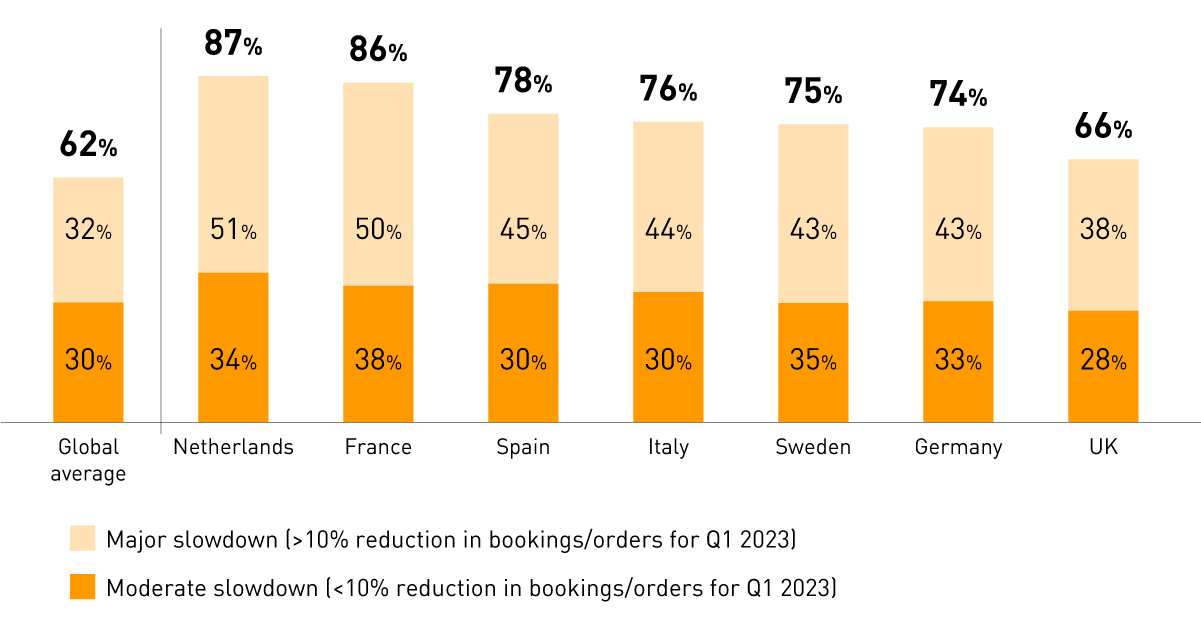
Source: Capgemini Research Institute, Global Investment Research, November–December 2022
When it comes to industries, the survey showed that retail, insurance, life sciences, and healthcare are most affected by the crisis, with two-thirds of managers seeing a slowdown and more than one-third of organizations reporting a significant reduction in orders for Q1 2023.
The best-performing of the industries analyzed is automotive, where “just” slightly more than one-fifth of companies are reporting order reductions of more than 10% (Fig. 2).
Figure 2 – Percentage of executives stating that their business is experiencing a slowdown, by sector.
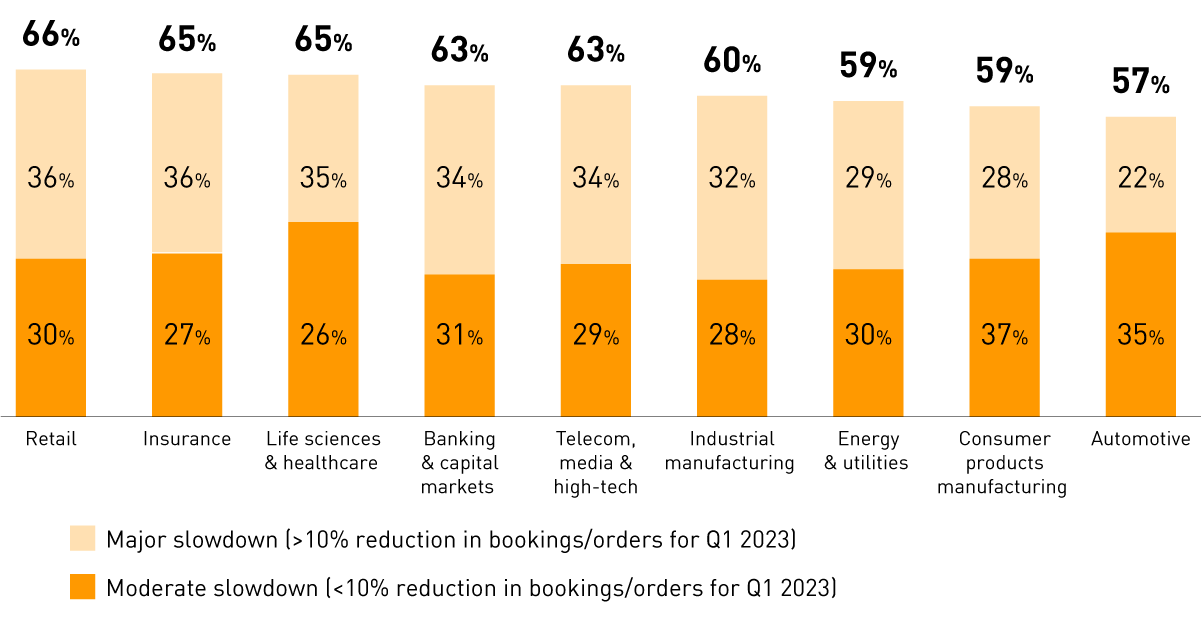
Source: Capgemini Research Institute, Global Investment Research, November–December 2022
IT spending remains recession-proof
Turbulent economic reality and uncertain future perspectives are forcing companies to seek savings and cost optimization across the board. Delaying or reducing investments is one of the standard actions that companies usually respond to a crisis.
However, not all investments will be subject to limitations. IT is one of those areas where companies are not planning to cut spending. On the contrary. Various surveys indicate that despite economic headwinds, a significant number of businesses plan to continue or even increase their investment in technology this year.
Apparently, having learned their lesson from the pandemic, companies are now fully aware that investing in technological development is one of the key factors enabling them to survive and even thrive in times of crisis.
Finally, it should not be forgotten that modern technologies lead to significant savings for the enterprise by achieving higher efficiency, better productivity, greater competitiveness and resilience to turbulence.
According to a recent survey that IBM commissioned from Morning Consult, 78% of global business leaders said that their organizations would be prioritizing or increasing investments in technology in the next 12 months. Only 18% said they would depreciate or reduce spending on IT solutions.
Importantly, IT investment topped the list of investment priorities, ahead of all other domains, including research and development, ESG goals, operations, marketing and communications, or even customer service (Fig. 3).
Figure 3 – How businesses plan to prioritize or increase invest in the next 12 months.
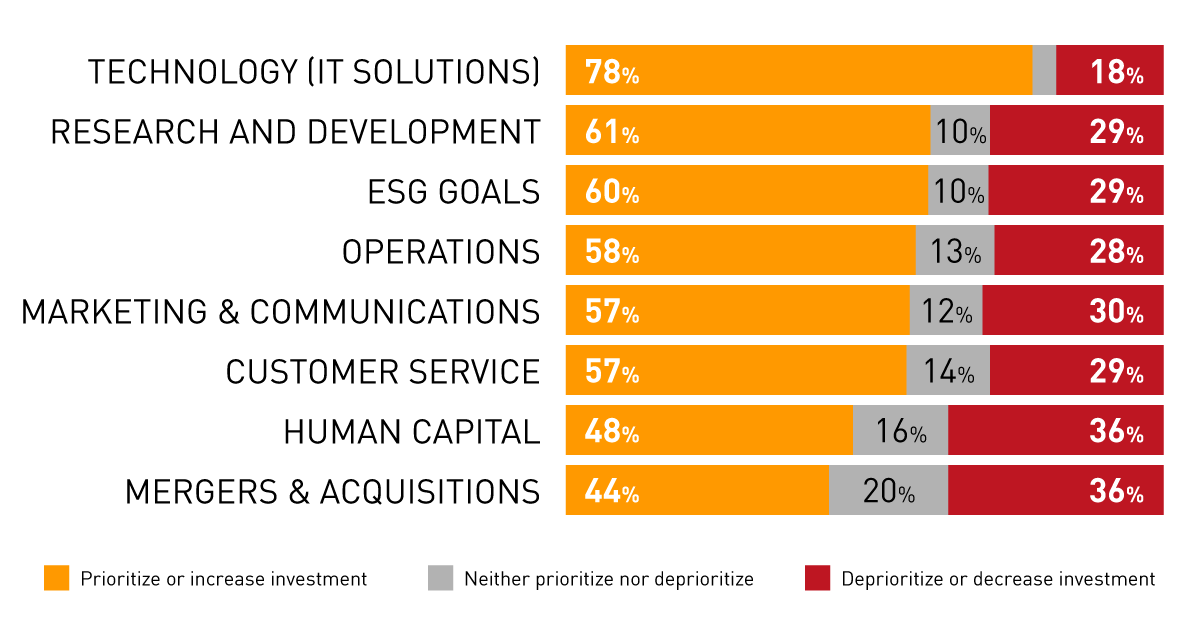
Source: “Global Technology Investment Predictions Report”, Morning Consult, IBM, November 2022
Gartner’s latest estimate from Q4 2022 shows that global IT spending will grow by 2.4% to $4.5 trillion in 2023 (Table 1).
The lion’s share of Gartner’s projected growth will come from investments in software and IT services.
Total global spending on software will increase from $783.5 billion in 2022 to $856 billion in 2023, a 9.3% growth.
The market for IT services is on the rise, as many companies rely on external experts for implementation and support. For this reason, Gartner expects growth of 5.5% here this year.
It is also worth pointing out that spending on consulting, which is part of IT services, is expected to reach USD 264.9 billion in 2023, an increase of 6.7% compared with 2022.
Table 1 – Worldwide IT spending forecast (millions of USD).
| 2022 SPENDING | 2022 GROWTH | 2023 SPENDING | 2023 GROWTH | |
| DATA CENTER SYSTEMS | 212,376 | 12.0% | 213,853 | 0.7% |
| SOFTWARE | 783,462 | 7.1% | 856,029 | 9.3% |
| DEVICES | 722,181 | -10.6% | 685,633 | -5.1% |
| IT SERVICES | 1,244,746 | 3.0% | 1,312,588 | 5.5% |
| COMMUNICATION SERVICES | 1,422,506 | -2.4% | 1,423,367 | 0.1% |
| OVERALL IT | 4,385,270 | -0.2% | 4,491,471 | 2.4% |
Source: Gartner, January 2023
IT investment priorities
According to a study by Capgemini, companies will prioritize technologies to reduce costs over the next 12 to 18 months.
Nearly three in four (72%) business executives surveyed said they would be looking to make significant technology investments to reduce long-term cost, while 59% would be investing in technology to support faster decision-making.
Global business leaders’ top priorities for planned IT investments include:
- IT infrastructure and cloud (44% plan to increase spend in this area)
- cybersecurity (42%)
- data and analytics (41%)
- intelligent automation (38%)
Importantly, IT executives show similar priorities. The Gartner survey revealed that CIOs’ future technology plans are focused on optimization (which also leads to cost reductions) rather than growth.
CIO’s top areas of increased investment for 2023 include:
- cyber and information security (66%)
- business intelligence and data analytics (55%)
- cloud platforms (50%)
Now, let’s take a look at the types of technologies in which companies want to invest in the near future (Fig. 4).
According to an IBM and Morning Consult survey, at the top of enterprises’ investment plans for the next 2 years are:
- 5G (39% of companies surveyed plan to invest in this technology)
- cybersecurity (36%)
- Internet of Things (35%)
- artificial intelligence and machine learning (33%)
- cloud computing (32%)
Figure 4 – Percentage of companies that plan to invest in these types of technologies in the next two years.
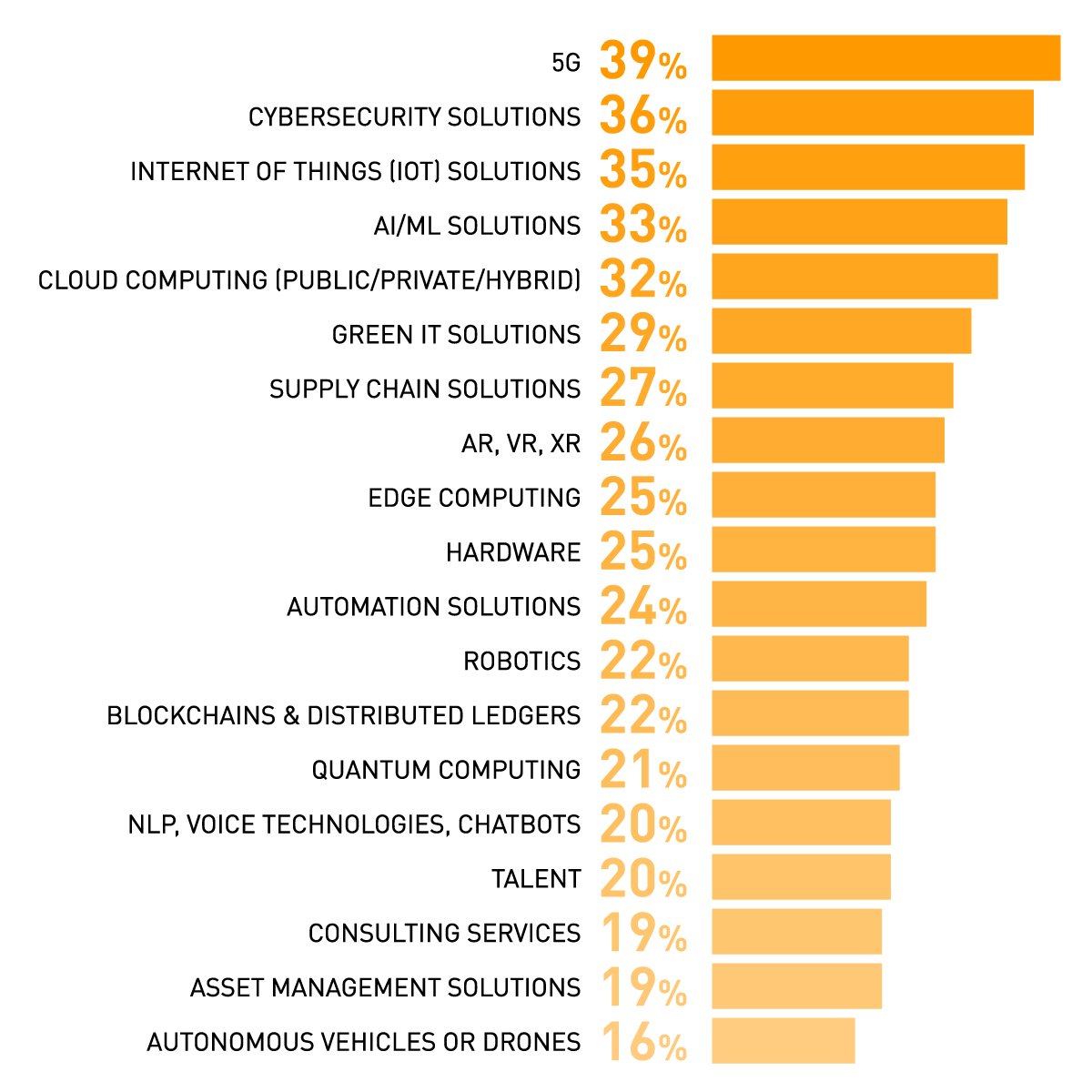
Source: “Global Technology Investment Predictions Report”, Morning Consult, IBM, November 2022
Base: Leaders who reported prioritizing tech investments in the next 12 months
Industry perspective
Different industries have their own priorities for planned initiatives and investments, a recent Gartner study showed (Fig. 5).
Growth is still the #1 priority for most industries, including:
- retail (indicated by 35% of respondents representing this industry)
- consumer goods (33%)
- life sciences (33%)
- automotive (30%)
- banking and investment (23%)
- manufacturing (22%)
Growth is an ambitious goal, especially in times of crisis. After all, customers need to be convinced to make (more) purchases despite the precarious situation.
This makes it all the more puzzling that only two industries pointed customer/user experience as their top enterprise priority. These were insurance (22%) and higher education (20%).
Another surprising finding is that only two industries – energy (26%) and life sciences (21%) – ranked leveraging and utilizing data effectively among their top three priorities.
Importantly, respondents from the energy industry indicated this priority as their top one. This confirms the data-driven change that has been observed in this industry for some time.
“We see that energy companies are increasingly collecting customer data, such as their energy consumption levels, on the one hand, and all data related to energy production, storage, and transmission, on the other.” – explains Krzysztof Wiśniewski, Senior System Architect at Striped Giraffe. “To this end, they are introducing smart meters and sensors in their power grids and power generation equipment such as boilers, turbines or solar panels.”
Advanced analytics of the data obtained, leveraging predictive capabilities, allows them among other things to:
- identify patterns of energy consumption in different time perspectives and areas, and develop energy delivery models
- anticipate changes in market demand in real time and adjust production accordingly
- monitor and reduce grid downtime
- determine cost-savings opportunities
- predict equipment performance – create models anticipating potential failures, lifespan and maintenance needs to plan for replacements or reduce downtimes
- monitor environmental issues, reduce pollution, and comply with emission regulations
- plan the production of electricity from renewable sources with respect to variable weather conditions
Figure 5 – Top three enterprise priorities by industries.
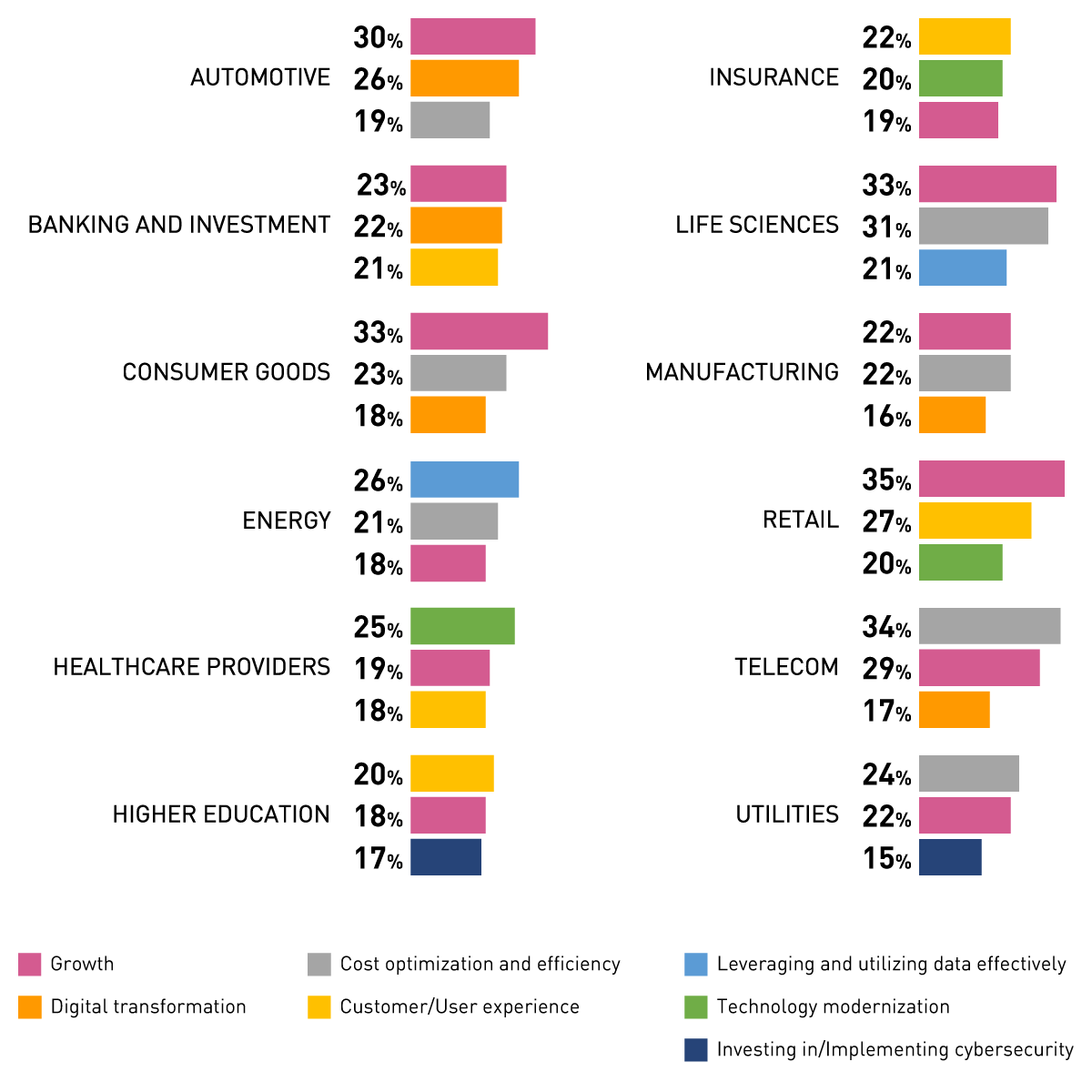
Source: 2023 Gartner CIO and Technology Executive Survey
As for planned IT investments in 2023 (Fig. 6), the survey showed that regardless of industry, companies plan to increase their spending mainly in three areas:
- cybersecurity / information security
- business intelligence / data analytics
- cloud platforms
For 10 out of 12 industries considered, cybersecurity/information security tops the list of areas in which companies will spend more this year. These are the following industries:
- utilities (77% of respondents will spend more in 2023 compared with 2022)
- healthcare providers (75%)
- automotive (72%)
- higher education (70%)
- retail (68%)
- consumer goods (67%)
- energy (66%)
- manufacturing (66%)
- banking and investment (63%)
- and telecom (61%)
Cybersecurity is very important for companies from the finance and insurance sectors due to legal requirements but also to win/keep their customers’ trust.
These industries are particularly exposed to fraud and phishing attempts, as well as hacker attacks. Protecting the assets of both the institution itself and its customers is therefore a primary goal of cybersecurity, especially in the era of increasing popularity of digital payment and settlement methods.
After all, it would cost these companies a lot more if they lost their reputation and their customers turned to competitors or, worse, switched back to analog products and processes.
Notably, artificial intelligence has not been at the forefront of technologies that could benefit from increased funding in 2023. Only two industries – energy (40%) and life sciences (51%) – placed AI among the five areas with planned increases in investment spending.
Figure 6 – Top five areas with declared increase in investment in 2023 compared to 2022, by industry.
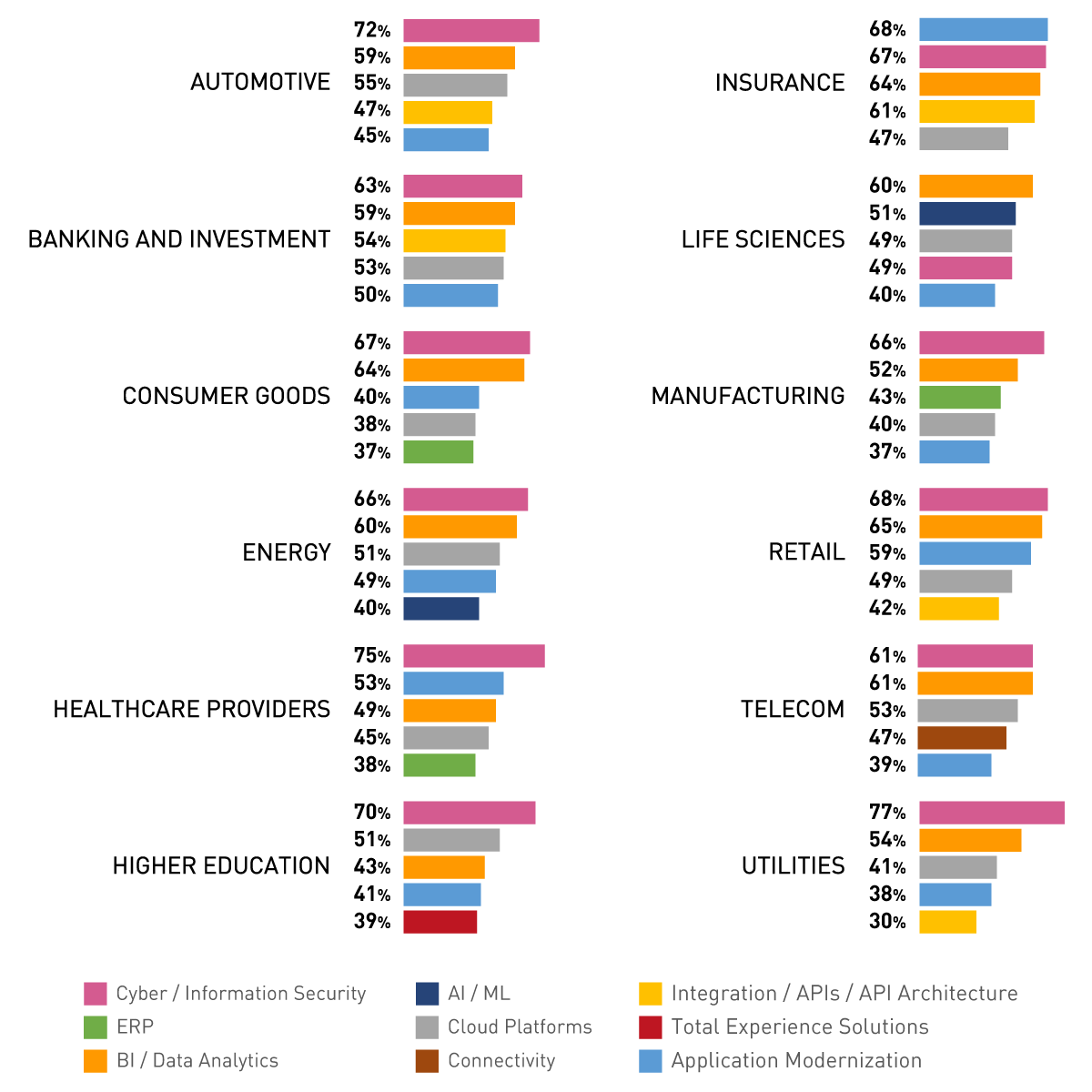
Source: 2023 Gartner CIO and Technology Executive Survey
Remarkably, respondents from all industries identify artificial intelligence as the technology most likely to be implemented by 2025 (Fig. 7).
Figure 7 – AI is the No. 1 technology to be implemented in all industries by 2025.
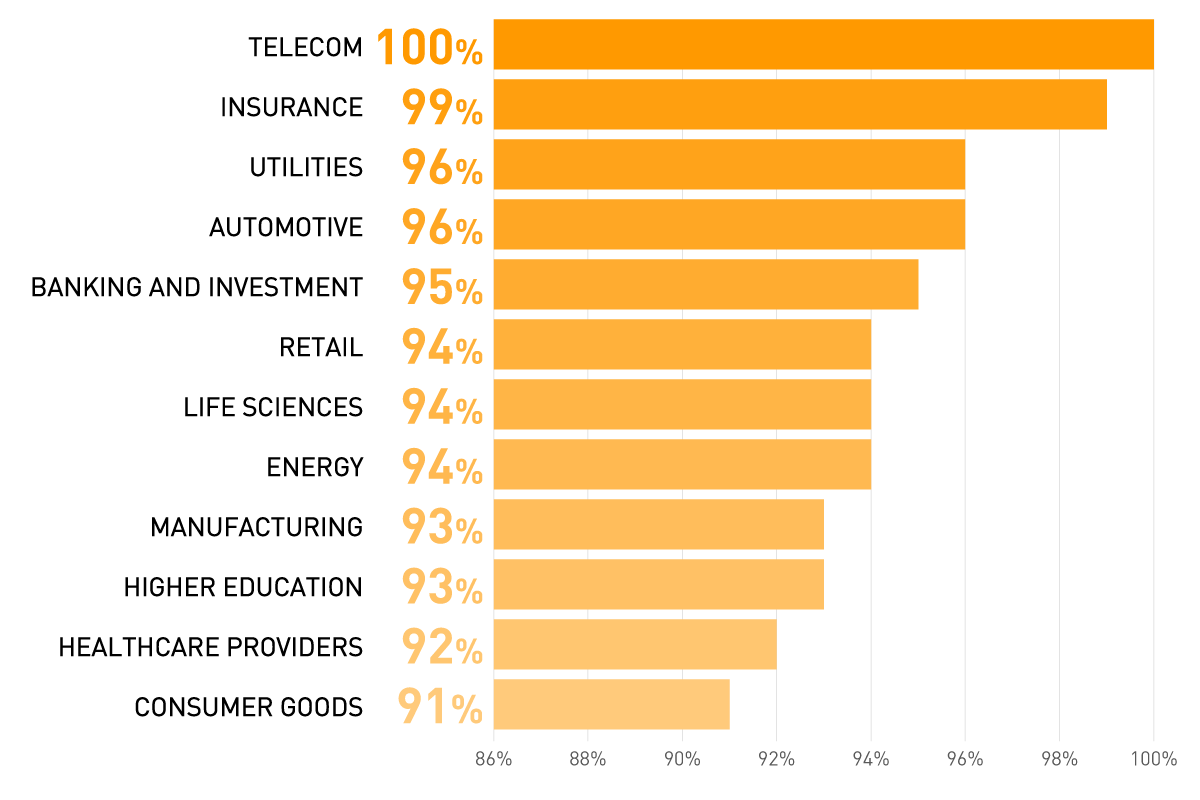
Source: 2023 Gartner CIO and Technology Executive Survey
The second technology with the highest chances of being adopted across industries by 2025 is distributed cloud (Fig. 8).
Depending on the industry, the intention to implement a distributed cloud was indicated by 76% to 92% of respondents. The largest percentage of companies plan to deploy this technology in healthcare (92%), telecom (92%), higher education (90%), energy (89%) and retail (89%).
Figure 8 – Industries declaring adoption of distributed cloud by 2025.
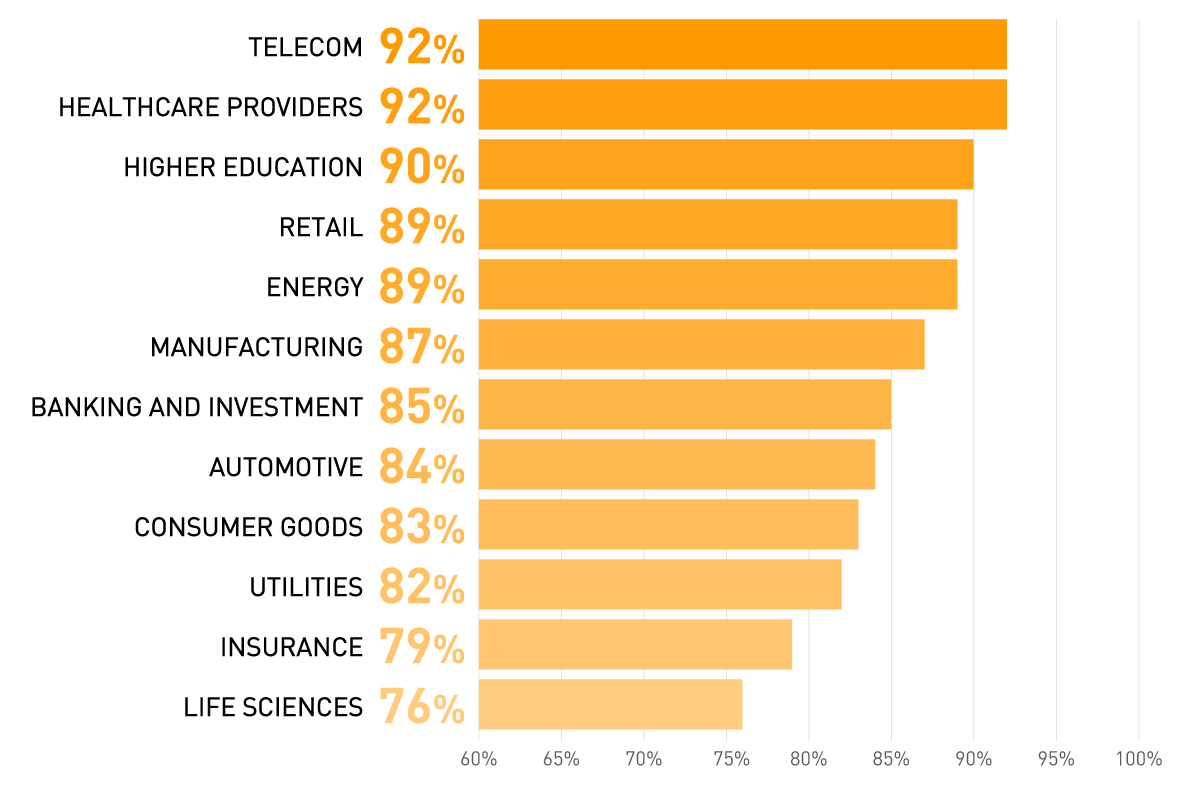
Source: 2023 Gartner CIO and Technology Executive Survey
Interestingly, Gartner’s list of technologies most likely to be implemented by 2025 included the digital twin (Fig. 9), which we wrote about in our article on data management trends.
A digital twin is a virtual model of a product, process, service, or person. It leverages AI/ML and advanced analytics to analyze real-time data, including information collected with sensors on the Internet of Things.
The captured data can be used to create a “digital twin” that can accurately predicts how these products, processes or services will work. This has become essential in modern technology and is used to drive innovation and performance.
In recent years, this concept has found application in many other industries, such as construction, logistics, automotive, medicine, healthcare, aviation, public administration and even veterinary medicine.
Currently, it is gaining momentum in commerce, offering the promise of delivering a digital model of the customer with their measurements, preferences, emotions, and shopping behavior.
In healthcare, digital twins offer groundbreaking applications in clinical trials, precision medicine, and public health. For example, they can be used to:
- simulate a patient to accurately test different treatments and predict their response to medication
- gain real-time insights into the use and performance of medical devices to optimize their utilization and anticipate the need for repair or maintenance
- plan bed occupancy in hospitals by predicting patient flow based on such data as population demographics and morbidity, community disease prevalence and transmission, etc.
Although digital twin was pointed in the survey much less frequently than the leaders of this ranking, it scored surprisingly high for several industries.
This shows that a significant percentage of companies perceive the digital twin as an important technology worth including in their investment plans through 2025.
Figure 9 – Digital twin ranks high in the investment plans of manufacturing companies.
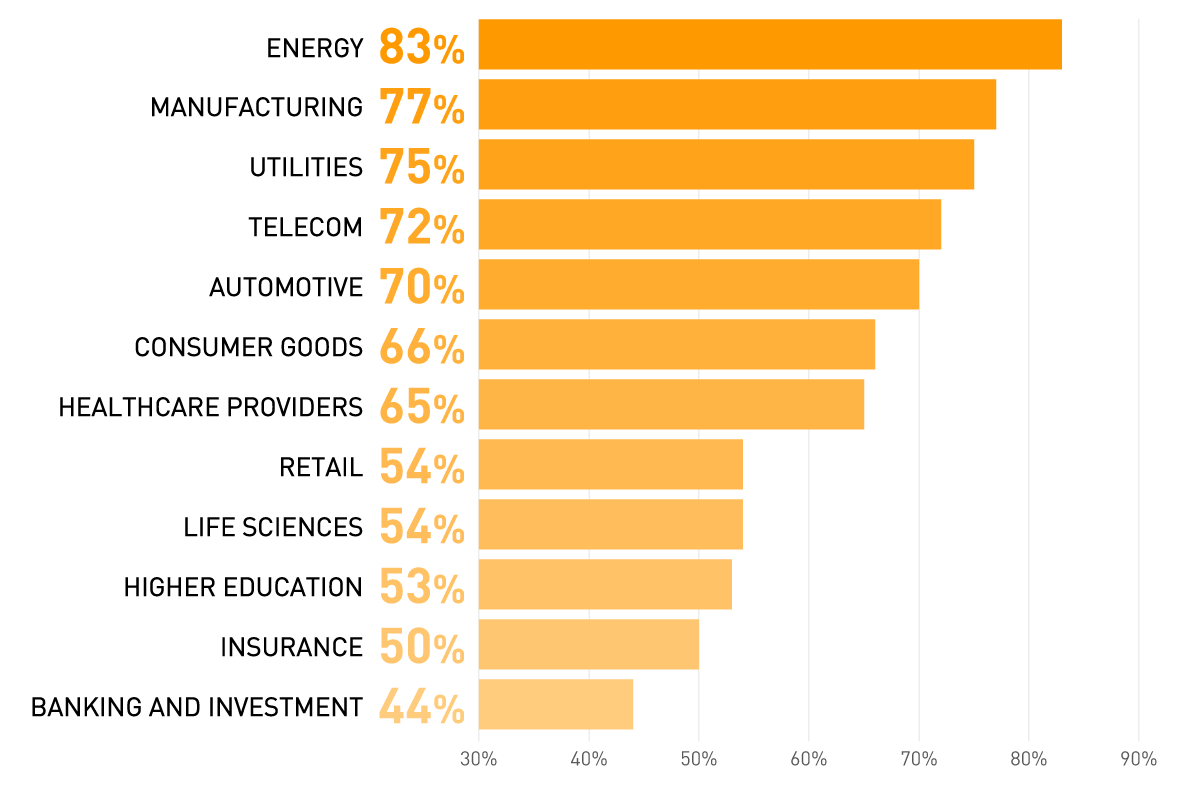
Source: 2023 Gartner CIO and Technology Executive Survey
Conclusion
Fortunately, the days when all IT spending was cut across the board during the crisis are over. Today, no one doubts that companies need to invest in modern IT solutions to meet current challenges and overcome turbulence.
With the help of the right technology solutions, processes and resource utilization can be optimized, cost savings can be realized, and operational efficiency can be achieved.
This can save other departments of a company from significant cost-cutting measures, project cancellations or staff reductions.
However, it is important to take a closer look at the IT solutions that will lead to the desired results and which results should be prioritized, especially in these challenging times.
As always, the right strategy comes first before allocating the IT budget. For this, it is expedient to call in pragmatic experts.
This might also be of interest to you:
BLOG
Data management trends to watch in coming years
Everybody talks about data and data-driven enterprise. Without a doubt, data-related topics will dominate technology trends for the coming years. That is why we decided to take a look at 5 hot topics that we think you should be keeping an eye on.
E-BOOK
Cloud DWH. Next-Generation Data Management
What are the biggest challenges? What are the advantages of a cloud solution? And how do you migrate an on-premise DWH to the cloud?
BLOG
What is Advanced Analytics and why is it so important for companies?
Advanced Analytics refers to a collection of different tools for the analysis of structured and unstructured data that allows the prediction of future events.
INTERVIEW
How buzzwords could put your IT at risk
Technology is evolving at a rapid pace. The IT world is constantly flooded with new hypes wrapped in buzzwords for IT managers to pounce on. Some see such innovations as a guarantee of success in an increasingly competitive market. But does embracing technology trends really increase the chances of success for your business?

